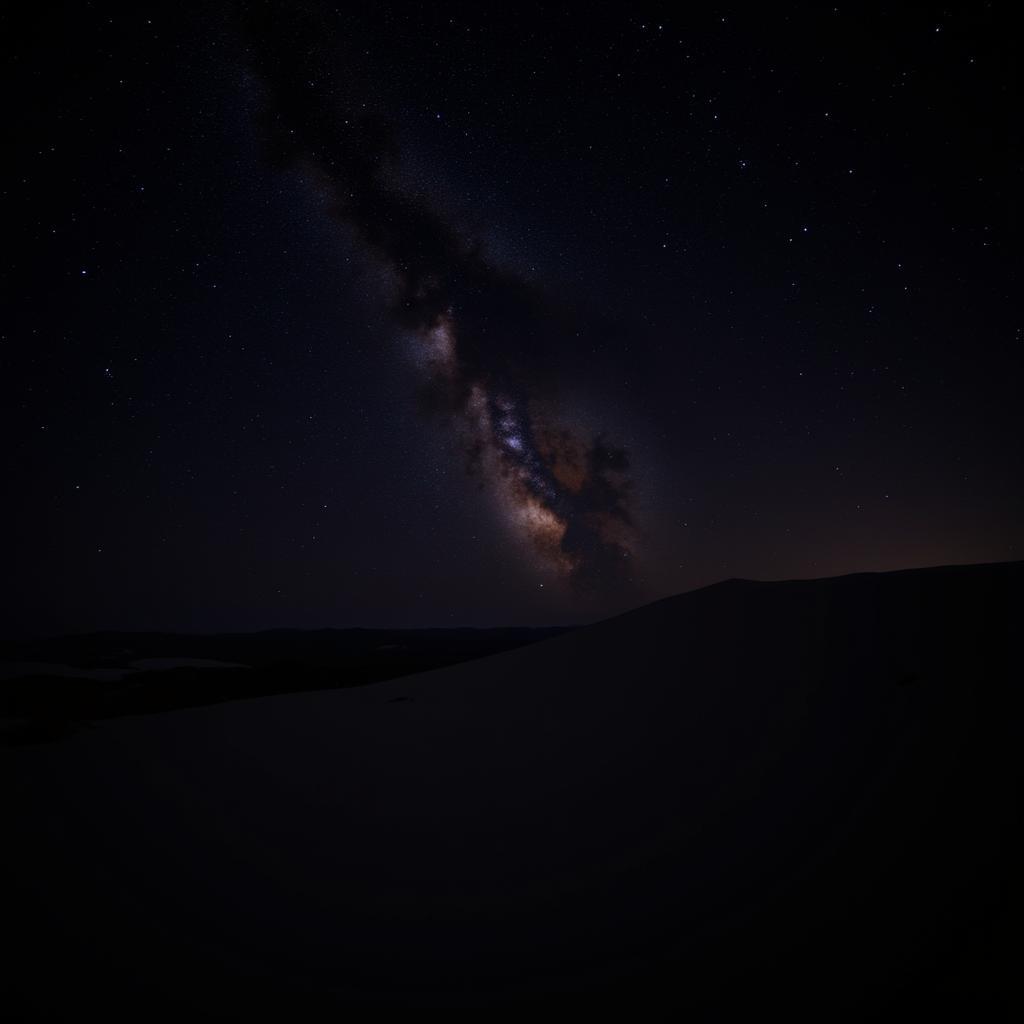Have you ever looked up at the night sky and wondered, what is the color of the Milky Way? It’s a question that has intrigued astronomers and stargazers for centuries. While it may appear white to the naked eye, the true color of our galaxy is a bit more complex than that. Let’s delve into the fascinating science and uncover the true hues of our cosmic home.
 Milky Way Spiral Galaxy in Night Sky
Milky Way Spiral Galaxy in Night Sky
Unveiling the Milky Way’s True Colors
The Milky Way’s color isn’t a single shade, but rather a composite of the light emitted from billions of stars and other celestial objects within it. To understand its color, we must consider the types of stars that populate our galaxy and the way their light interacts with interstellar dust. Our sun, for example, is a yellow-white star. what a colorado campfire is demonstrates other color aspects we see in nature. The Milky Way contains a multitude of stars, ranging from cool, red giants to hot, blue supergiants.
The Influence of Stellar Populations
The color of a galaxy is largely influenced by the age of its stars. Younger stars tend to be hotter and bluer, while older stars are cooler and redder. The Milky Way contains a mix of both young and old stars, resulting in a more complex color profile. The spiral arms, where star formation is active, are generally bluer due to the presence of young, hot stars. Conversely, the central bulge of the galaxy, populated by older stars, appears more reddish. Similar color phenomenon can be observed with other celestial bodies, just like what color are the coolest stars.
The Role of Interstellar Dust
Interstellar dust plays a significant role in shaping the Milky Way’s apparent color. This dust absorbs and scatters blue light more effectively than red light, a phenomenon known as reddening. As starlight travels through the dusty interstellar medium, the blue component is scattered away, resulting in a shift towards the red end of the spectrum. This effect is similar to how the setting sun appears redder due to the scattering of blue light in Earth’s atmosphere. Speaking of how light reflects and refracts, we can compare this with what color do diamonds reflect.
So, What Color is it Really?
Based on scientific studies, the Milky Way’s color has been described as “warm white,” similar to the color of spring snow in early morning sunlight. This slightly yellowish-white hue arises from the combined light of its diverse stellar population, filtered through interstellar dust.
“The Milky Way’s color is a testament to its complex history of star formation and the dynamic interplay between stars and interstellar dust,” says Dr. Amelia Carter, astrophysicist at the Galactic Research Institute.
What Color is the Milky Way from Earth?
From Earth, the Milky Way often appears as a faint, milky band across the night sky. Its visibility and perceived color can be affected by light pollution, atmospheric conditions, and the observer’s location. In areas with dark skies, the Milky Way can appear remarkably bright and detailed, revealing subtle color variations within its structure. Just like how colors interact and affect our perception, let’s consider what color is a cytoplasm or even what color is cvt fluid. These examples showcase the variety and complexity of color in different contexts.
“Observing the Milky Way from a dark sky location is a truly awe-inspiring experience. The sheer number of stars and the subtle variations in color are breathtaking,” remarks Professor David Lee, renowned astronomer and author of “Cosmic Canvas.”
Conclusion
The color of the Milky Way is a fascinating topic that combines astrophysics and our visual perception. While it appears white at first glance, its true color is a warm, slightly yellowish-white, resulting from the combined light of its billions of stars, modified by the presence of interstellar dust. Understanding the factors that contribute to its color deepens our appreciation for the complexity and beauty of our galaxy.
FAQ
- Is the Milky Way always the same color? No, its perceived color can vary depending on observing conditions and location.
- What is the most common star type in the Milky Way? Red dwarfs are the most common type of star.
- How does interstellar dust affect the color of the Milky Way? It scatters blue light, making the galaxy appear redder.
- Can we see the Milky Way’s true color with the naked eye? Under ideal dark sky conditions, we can perceive its warm white hue.
- Why do spiral arms appear bluer? They contain younger, hotter stars that emit blue light.
- What color is the center of the Milky Way? The center appears more reddish due to the presence of older stars.
- How does light pollution affect our view of the Milky Way? It makes it fainter and harder to see its true color.
Situations involving Milky Way color questions
Imagine discussing stargazing with friends and someone asks about the Milky Way’s color. You can now share your newfound knowledge and impress them with the intricate details of its true hue. Or perhaps you’re planning a trip to a dark sky location and want to know what to expect. Understanding the Milky Way’s color will enhance your viewing experience.
Further Exploration
For more information on related topics, you can explore articles about the colors of stars, nebulae, and other celestial objects. Learning more about the composition and properties of interstellar dust can also provide valuable insights into the Milky Way’s appearance.
Contact Us
Need assistance with your color choices or home design? Contact us at 0373298888 or email [email protected]. Visit our showroom at 86 Cầu Giấy, Hà Nội. Our 24/7 customer service team is ready to help.